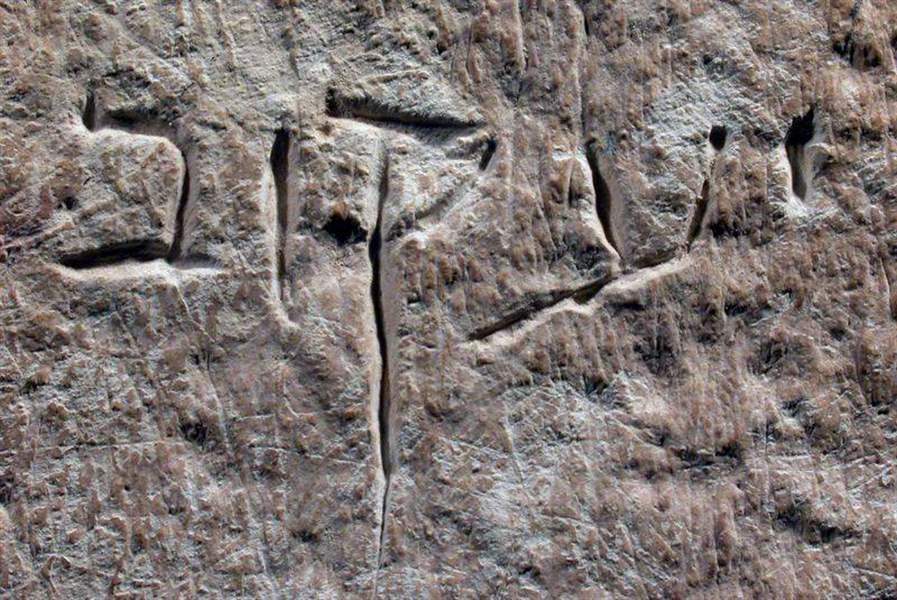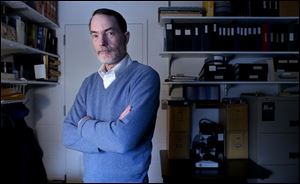
Debate continues over authenticity
1/24/2004
Detail of the ossuary inscription.

Dr. James Harrell is a professor of geology at UT.
“It's the Shroud of Turin all over again,” said Dr. James A. Harrell, a University of Toledo geology professor, of the James ossuary.
The significance of the first century limestone box, inscribed in Aramaic with the words, “James, son of Joseph, brother of Jesus,” will be debated for years by scientists, scholars, and theologians, he said, just as the authenticity of the shroud, said to have been wrapped around Jesus' body, remains in dispute.
A member of the Association for the Study of Marble and Other Stones in Antiquity, Dr. Harrell has written several articles on the ossuary, including “Flawed Geochemistry Used to Condemn James Inscription,” published in the January/February, 2004, edition of Biblical Archaeology Review.
When the existence of the James ossuary was first reported in 2002, it was hailed by many experts as a historic discovery.
Dr. Hershel Shanks, founder and editor-in-chief of Biblical Archaeology Review and author of The Brother of Jesus, said the box “may well be the most significant biblical archaeological find of our time and the first-ever physical link to the historical Jesus of the New Testament.”

Detail of the ossuary inscription.
Ossuaries were commonly used in first century Israel for burying the bones of the deceased, whose bodies were left to decay for about a year and then the bones put into a small box for burial.
Before the discovery of the ossuary, there was no other evidence of Jesus' life except for what was written in texts. If authentic, the box would be the first tangible proof of Jesus' existence and its significance, therefore, would be unparalleled in biblical archaeology.
There is no dispute that the 20-inch-long ossuary is from first century Palestine, Dr. Harrell said, but questions focus on the age of its inscription.
Last June, the Israel Antiquities Authority rejected the inscription as a modern forgery.
Dr. Harrell, in an interview this week, said that after examining the available scientific data, he is certain that the IAA's evaluation was flawed.
“Basically what I'm saying is that the scientific evidence is inconclusive. But that is substantial because the IAA, in their report, claim the inscription is a forgery - no ifs, ands, or buts about it.”
Dr. Harrell, who has taught at UT for 25 years, said none of the data used in the IAA's report can justify the agency's outright rejection of the box's authenticity.
“It may be that they're ultimately right in their conclusion, but if so it would be for the wrong reasons,” Dr. Harrell said. “I haven't made my mind up yet as to whether I think it's authentic or not, but the balance is in favor of authenticity.”
Dr. Harrell has not examined the ossuary itself, but, at the request of Dr. Shanks, has studied the data released by Israeli authorities.
An expert on ancient stones, especially Middle Eastern stones, Dr. Harrell has studied the chemical composition of the brown patina, or thin coating, that covers most of the limestone box.
He said it is obvious that somebody cleaned the ossuary, possibly with a metallic pad, since it was purchased more than 30 years ago by its current owner, Ogded Golan, an Israeli antiquities dealer who reportedly tried to sell the ossuary for $2 million.
“Whenever inscribed objects are found, perhaps in illicit excavations, they're cleaned up and made presentable,” Dr. Harrell said. “An archaeologist would never do that, but an antiquities dealer would.”
Mr. Golan has been vague about where he got the ossuary, but Dr. Harrell said the owner told him at a conference in Atlanta last year that he bought the box in Jerusalem. Its importance was not discovered, however, until Andre Lemaire of the Sorbonne translated the Aramaic in April, 2002.
The scrubbing altered the chemical composition of the patina, but the coating on the word “Jesus” is the same as the overall patina on the limestone, Dr. Harrell said.
“When you write the inscription, Jesus is the last word you put on there. And if that is, by all indications, ancient and authentic - and even the IAA says that word is ancient - then the rest of the inscription had to have been written first,” he said.
Another argument scholars have made in the ossuary debate is that the names Jesus, Joseph, and James were fairly common in ancient Israel, so even if the data indicate the inscription is genuine, it still would not prove conclusively that the words refer to Jesus of Nazareth.
On scientific standards alone, the IAA report was amateurish, Dr. Harrell said.
“It was a rush job, it was not well written, there were no reasons given for conclusions, no mention of dissenting views,” he said. “It was just badly done.”
Perhaps, he said, the Israeli government was trying to make an example of Mr. Golan to discourage people from selling archaeological treasures - even though Mr. Golan's purchase was legal at the time.
Dr. Harrell said he thinks Israeli authorities were unprepared for a serious scientific study of the ossuary.
“What I think happened is that they threw this committee together very quickly. It's like a road accident: The first people on the scene are not always the best to help. That's exactly what happened. I think there will be another, better-qualified committee to study it and issue a new report.”
Dr. Harrell said Dr. Shanks has asked him if he would consider organizing such a blue-ribbon panel.
“I sort of welcome the opportunity, and in a way I don't,” Dr. Harrell said. “It's such a controversial issue. You can get caught up with it. Not everybody's going to be happy with what you do, no matter what your conclusion.”